After lower back pain, knee pain is the second most common. Therefore, it
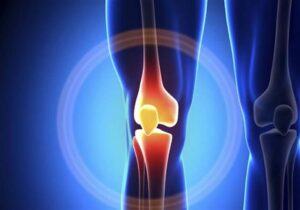
may be a good idea to know all about knee pain because sooner or later everybody experiences it to some degree. It is one of the most common complaints from individuals of all ages.
What causes knee pain
Knee pain can result from an injury or medical condition such as arthritis or other condition. The location and degree of knee pain often varies with each individual depending on the cause of the problem.
Injuries
A knee injury can cause problems to any of the numerous ligaments, tendons, cartilage or bursae sacs that surround or are a part of the knee joint. Some of the most common knee injuries are:
- Anterior cruciate ligament (ACL)
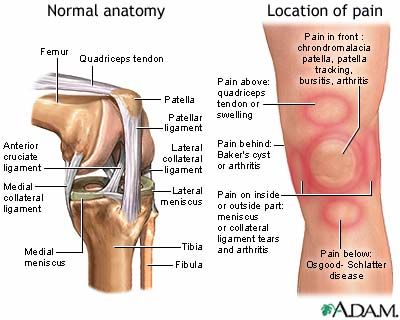
- Meniscus
- Bursitis
- Tendinitis
- Anterior cruciate ligament (ACL)
Let’s look at these individually:
Anterior curciate Liagament (ACL) – This is a major ligament of the knee that helps to stabilize the knee joint. It joins the thighbone (femur) to the shinbone (tibia). ACL injuries occur mostly during sports that involve abrupt stops or changes in direction, jumping and landing — such as soccer, basketball, football and skiing.
Depending on the severity of the ACL injury, treatment can include rest and rehabilitation exercises to help regain strength and stability. Surgery may be needed to replace the torn ligament followed by rehabilitation. An appropriate training program can help reduce the risk of this type of injury.
Symptoms of an ACL injury include:
- A noisy “pop” or a “popping” feeling in the knee
- Serious pain and incapability to continue activity
- Abrupt swelling
- Decrease in range of motion
- A feeling of unsteadiness or “giving way” with weight bearing
Individuals who experience an ACL injury are at higher risk of developing osteoarthritis in the knee.
Correct training and exercise can help reduce the risk of an ACL injury
Meniscus – The meniscus is a piece of tough, rubbery cartilage that acts as a shock absorber and supplies a cushion between the shinbone and thighbone and is C-shaped. It can be torn if by a sudden twist of the knee while applying weight on it.
A torn meniscus causes pain, swelling and stiffness. An individual might also feel a block to knee motion and have difficulty extending the knee fully.
A torn meniscus can result from any activity that causes an individual to forcefully twist or rotate the knee, such as forceful pivoting or abrupt stops and turns. Even kneeling, deep squatting or lifting something heavy can on occasion lead to a torn meniscus.
In older, senior adults, degenerative changes of the knee can contribute to a torn meniscus with little or no trauma.
Obesity also increases the risk of a torn meniscus.
Treatment can be moderate which would include rest, ice and medication. This is sometimes enough to relieve the pain of a torn meniscus and give the injury time to heal on its own. However, in other cases, a torn meniscus requires surgical repair.
Symptoms include:
- A popping sensation
- Swelling and or stiffness
- Pain, mostly when twisting or rotating the knee
- Difficulty straightening the knee completely
- A Feeling as though the knee is locked in place when attempting to move it
- Feeling of the knee giving way
An individual might be more likely to develop osteoarthritis with this type of knee injury.
Bursitis – can be a painful condition that affects the tiny, fluid-filled sacs — 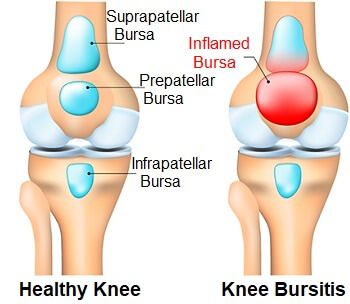 called bursae (bur-SEE) which cushion the bones, tendons and muscles near the joints. Bursitis occurs when bursae grow to be inflamed.
called bursae (bur-SEE) which cushion the bones, tendons and muscles near the joints. Bursitis occurs when bursae grow to be inflamed.
The most common locations for bursitis are within the shoulder, elbow and hip. But it can also occur in the knee, heel and the base of the big toe. More often than not, this injury is caused by repetitive movements.
The most familiar causes of bursitis are repetitive actions or postures that put pressure on the bursae around a joint. Examples include:
- Pitching a baseball or hoisting something over your head repeatedly
- Leaning on your elbows for long periods
- Considerable kneeling for tasks such as laying carpet or scrubbing floors
Other causes can include injury or trauma to the affected area, inflammatory arthritis such as rheumatoid arthritis, gout and infection.
An injury can also cause irritation to the tissue inside the bursa and cause inflammation. Bursitis caused by an injury generally takes time to develop. The joints, tendons, or muscles that are near the bursa might have been overused.
Symptoms of the infected joint include:
- Feeling achy or stiff
- Hurt more when it is moved or pressed on
- Appears swollen and red
Even though not all types of bursitis can be prevented, an individual can reduce the risk and the gravity of flare-ups by changing the way certain tasks are performed. Examples include:
- Lifting properly. Bending the knees when lifting. Failing to do so puts extra stress on the bursae in the hips.
- Wheeling heavy loads. Carrying heavy loads puts stress on the bursae in the shoulders. Use a dolly or a wheeled cart instead.
- Using kneeling pads. Use some form of padding to lessen the pressure on the knees if the job or hobby requires a lot of kneeling.
- Taking frequent breaks. Alternate repetitive tasks with rest or other activities.
- Maintaining a healthy weight. Excessive weight places more stress on the joints.
- Exercising. Strengthening the muscles can help protect the affected joint.
- Warming up and stretching before strenuous activities to protect the joints from injury.
Tendinitis – Tendinitis is irritation or inflammation of a tendon (s). They are the thick fibrous cords that attach muscle to bone. This condition causes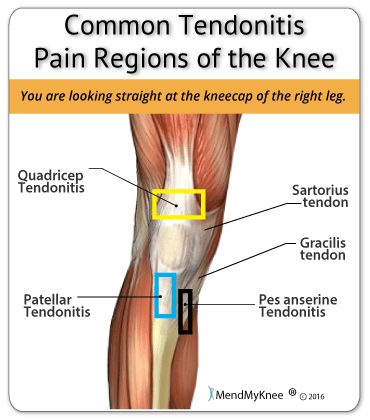 pain and tenderness just outside of a joint.
pain and tenderness just outside of a joint.
While tendinitis can occur in any of the tendons, it’s most typical in the shoulders, elbows, wrists, knees and heels.
There are a few common names for various tendinitis problems which are:
- Pitcher’s shoulder
- Swimmer’s shoulder
- Tennis elbow
- Golfer’s elbow
- Jumper’s knee
Even though tendinitis can be caused by a sudden injury, as with bursitis the condition is much more likely to stem from the repetition of a particular movement over time. The majority of individuals develop tendinitis because their occupations or hobbies involve repetitive motions that put stress on the tendons.
Using the proper technique is particularly important when engaging in repetitive sports movements or job-related activities. Improper technique can overwork the tendon — which it the case with tennis elbow — and lead to tendinitis.
Signs and symptoms of tendinitis tend to occur at the location where a tendon attaches to a bone. This typically includes:
- Pain often depicted as a dull ache, especially when moving the affected limb or joint
- Mild swelling
- Tenderness
- – Risk factors for developing tendinitis consist of age, working in particular occupations or participating in certain sports.
- Age – As individuals get older, their tendons become less flexible — which makes them easier to injure.
- Occupation – Tendinitis is more common in people whose jobs involve:
- Repetitive motions
- Awkward positions
- Frequent overhead reaching
- Vibration
- Forceful exertion
- Sports – One may be more likely to develop tendinitis if they participate in certain sports that entail repetitive motions, especially if their technique isn’t the best. This can occur with:
- Baseball
- Basketball
- Bowling
- Golf
- Running
- Swimming
- Tennis
- Sports – One may be more likely to develop tendinitis if they participate in certain sports that entail repetitive motions, especially if their technique isn’t the best. This can occur with:
Without suitable treatment, tendinitis can increase the risk of experiencing tendon rupture — a much more serious condition that may require surgery.
If tendon irritation persists for several weeks or months, a condition known as tendinosis may result. This condition involves changes that can weaken the tendon, along with abnormal new blood vessel growth.
Medical Conditions
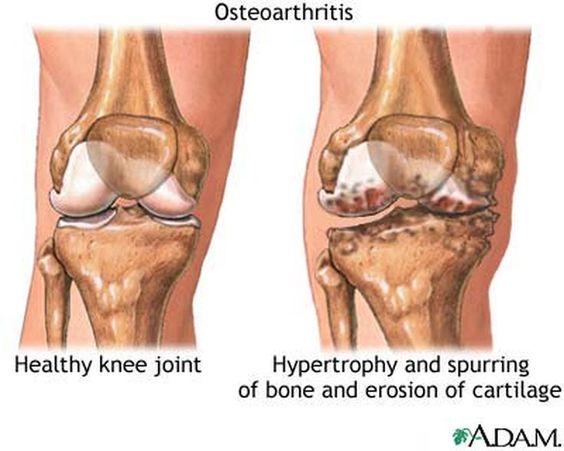
In addition to injuries, there are other medical conditions that can cause knee pain. A major one is arthritis. There are more than one-hundred (100) different types of arthritis in existence. Examples of the ones that cause knee pain are:
- Osteoarthritis – (AKA OA)—is a progressive condition that slowly wears away joint cartilage. It is the most common chronic joint condition. OA is most likely to occur after middle age although it can occur at any age. The most common symptoms are:
- pain
- tenderness (discomfort when pressing on the area with your fingers)
- stiffness
- inflammation
- Rheumatoid arthritis – OA and rheumatoid arthritis (RA) share the same symptoms but are very different conditions. OA is a degenerative condition, which means that it increases in severity over time. RA, on the other hand, is an autoimmune disorder (basically when the immune system attacks the body). People with RA have immune systems that mistake the soft lining around joints to be a threat to the body, causing it to attack that area. This soft lining, which includes the synovial fluid, is called the synovium (connective tissue). As the immune system launches its assault, fluid buildup within the joint occurs, causing stiffness, pain, swelling, and inflammation.
- Gout – is a painful form of inflammatory arthritis that usually affects the big toe, however, it can develop in any joint, including one or both of the knees. Gout forms when the body has high levels of uric acid. This substance forms sharp crystals that cause sudden bouts of pain, swelling, and tenderness. The main symptom of gout within the knee is pain and discomfort in the surrounding area.
- Pseudogout – a type of arthritis that causes impulsive, painful swelling in the joints. It happens when crystals form in the synovial fluid, the fluid that lubricates the joints. This leads to inflammation and pain. This condition most often affects the knees, but it can affect other joints as well. It’s more frequent in adults over the age of 60.
- Osteoarthritis – (AKA OA)—is a progressive condition that slowly wears away joint cartilage. It is the most common chronic joint condition. OA is most likely to occur after middle age although it can occur at any age. The most common symptoms are:
Mechanical problems
Another class of problems that can cause knee pain is mechanical problems. These include:
- Loose piece of cartilage or bone
- Dislocated kneecap
- Gait (how you walk) change because of hip or foot pain
Treatments
Not all knee pain is serious, but a range of injuries and conditions can lead to increased pain, joint damage and disability if left untreated. There are numerous ways to treat knee pain, depending on the severity of the pain and the damage to the knee. Examples of knee pain treatment include:
- Medication
- Physical therapy
- Injections
- Osteopathic manipulation
- Surgery
There are additional ways that knee pain can be treated at home, such as over-the-counter pain medication, ice, rest, elevation and compression.
While it is not always possible to prevent knee pain, there are a few options that can help stave off knee problems in the future:
- Maintain a healthy weight
- Warm up and stretch before physical activity
- Exercise appropriately for your body
- Build up muscle
- Wear proper shoes
There is one more thing that can help ward off knee and joint issues: take a 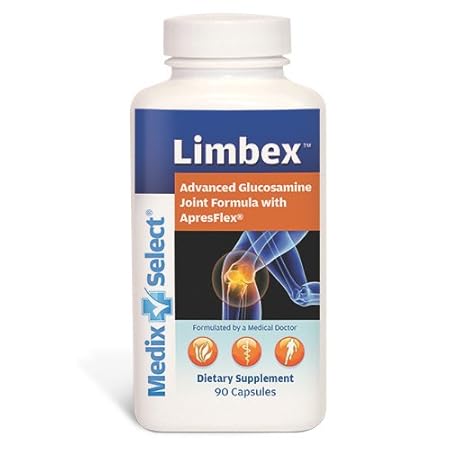 supplement. We’ve come a long way since the singular multiple-vitamin.
supplement. We’ve come a long way since the singular multiple-vitamin.
There are supplements specifically for joint health and maintenance. Click here (Paid link) for more information.
Prevention is better than cure!
Please feel free to leave any comment, question, or concern below.
Good Health!
I always find it useful to get at the very least, a basic knowledge of common maladies such as knee pain. I think its useful because as you said, it is common among individuals of all ages.
The anterior cruciate ligament is one that I’ve come to get an understanding of, but in a very limited capacity. I play soccer regularly so I’ve seen my fair share of such injuries.
I have to say though, this article have made it easier to understand and I’ll be sure to share with my friends.
Regards
Hi Rhain – I’m happy that the article has clarified things regarding knee injuries for you. I hope your injuries has or will heal promptly. Thanks for commenting and thanks for sharing the information with your friends.
Have a great day!
Thanks for the detailed explanation of knee pain. I have knee pain every day, and have had since university (35 years ago), It was caused by a volleyball injury. Being the manly man that I was, I did not seek medical attention.
Live and learn.
Your article has made it clearer where the pain is coming from. I have learned to live with it, so I won’t be seeking any remedies. You were very detailed in bot your description of where the pain may be coming from and of possible remedies.
I now warm up and take special care not to aggravate.
Thanks again for the very informative article.
Have a great day!
Tom
You’re welcome Tom. Thanks for commenting and all the best with your knee. Try a natural supplement to help with inflammation.